 W
WThe Kingdom of Romania was neutral for the first two years of World War I, entering on the side of the Allied powers from 27 August 1916 until Central Power occupation led to the Treaty of Bucharest in May 1918, before reentering the war on 10 November 1918. It had the most significant oil fields in Europe, and Germany eagerly bought its petroleum, as well as food exports.
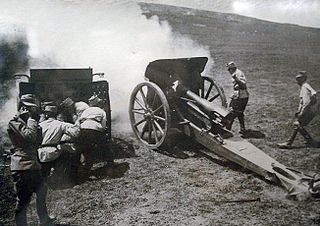 W
WThe Obuzierul Krupp, caliber 105 mm, model 1912 was a Romanian upgrade of the German 10.5 cm Feldhaubitze 98/09 howitzer used extensively during World War I. After two years of planning and experimentation by Romanian officers, the final design was approved and the required modifications were performed at Arsenalul Armatei in Bucharest. The German aiming system was replaced with an improved Romanian system and the maximum range was increased to 6,500 meters, being superior to the 6,300 meters maximum range of its German counterpart. Maximum elevation was also increased from 40° to 60°. Thirty batteries were converted by Arsenalul Armatei before and during World War I. They appear to have lingered in Romanian service into World War II. Guns captured by the Bulgarians appear to have been placed into service, although they seem to have been out of service by the outbreak of World War II.
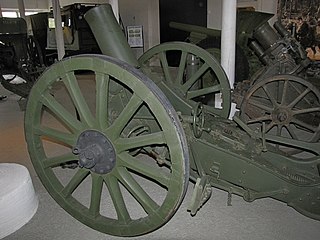 W
WThe 120 mm howitzer Model 1901 – was a German howitzer used by the Imperial Russian and Romanian Armies during the First World War.
 W
WThe A Vlaicu III was the world's first metal-built aircraft, designed and built in Romania prior to World War I. It was the third powered aircraft designed by pioneering Romanian aviator Aurel Vlaicu.
 W
WThe Armistice of Focșani was an agreement that ended the hostilities between Romania and the Central Powers in World War I. It was signed on 9 December 1917 in Focșani in Romania.
 W
WThe first cabinet of Alexandru Averescu was the government of Romania from 29 January - 4 March 1918.
 W
WThe third cabinet of Ion I. C. Brătianu was the government of Romania from 4 January 1914 to 10 December 1916. During this period Romania entered World War I on the side of the Allied Powers.
 W
WThe fourth cabinet of Ion I. C. Brătianu was the government of Romania from 11 December 1916 to 28 January 1918.
 W
WThe Treaty of Bucharest of 1916 was signed between Romania and the Entente Powers on 4 /17 August 1916 in Bucharest. The treaty stipulated the conditions under which Romania agreed to join the war on the side of the Entente, particularly territorial promises in Austria-Hungary. The signatories bound themselves to keep secret the contents of the treaty until a general peace was concluded.
 W
WThe Treaty of Bucharest (1918) was a peace treaty between Romania on the one side and the Central Powers on the other, following the stalemate reached after the campaign of 1917 left Romania isolated after Russia's unilateral exit from World War I.
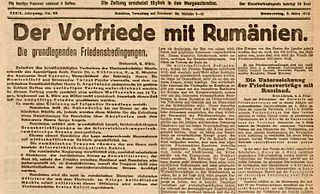 W
WThe Treaty of Buftea was a preliminary peace treaty between the Kingdom of Romania on one side and the Central Powers on the other.
 W
WThe cabinet of Constantin Coandă was the government of Romania from 24 October to 28 November 1918. This period was the closing days of World War I.
 W
WThe Democratic Peasants' Party, also known as Democratic Party, Peasants' Party, National Democratic Party or Unirea Society, was a provincial party in Bukovina, Austria-Hungary, one of several groups claiming to represent the ethnic Romanians. It had a national liberal and left-wing populist agenda, and was mainly supported by "the peasants, the village teachers, and some of the intellectuals." Its leader was Aurel Onciul, seconded by Florea Lupu, both of whom were adversaries of the conservative and elitist Romanian National People's Party (PNPR). Rejecting sectarianism, the PȚD combined Austrian and Romanian nationalism, as Onciul argued that Romanian aspirations could only be fulfilled inside the multi-ethnic empire. For this reason, and for its role in dividing the Romanian vote, the party was often accused of double-dealing.
 W
WThe Eastern Front or Eastern Theater of World War I was a theater of operations that encompassed at its greatest extent the entire frontier between the Russian Empire and Romania on one side and the Austro-Hungarian Empire, Bulgaria, the Ottoman Empire and the German Empire on the other. It stretched from the Baltic Sea in the north to the Black Sea in the south, involved most of Eastern Europe, and stretched deep into Central Europe as well. The term contrasts with "Western Front", which was being fought in Belgium and France.
 W
WThe Fahrpanzer was a mobile artillery piece made prior to World War I in Germany, implemented in several German fortifications from 1890 onwards and exported to several foreign military powers prior to the outbreak of hostilities.
 W
WThe French military mission to Romania was a mission led by led by General Berthelot, and sent from France to help Romania during World War I. French officers, aviators and medical staff trained and supported the Romanian army. As the Bolshevik took power in Russia and began negotiations for ending hostilities, Romania signed an armistice in December 1917 and sent the military mission back to France.
 W
WThe Labor Party was a minor left-wing political group in Romania. Based in the city of Iași, and founded by George Diamandy, in its inception it was a split from the National Liberal Party (PNL). The PM responded to the major social and political crisis sparked by World War I, with the southern regions of Romania having been invaded and occupied by Germany. It notably pushed for urgent land reform, universal suffrage, and labor rights, also wishing to replace the 1866 Constitution with a more democratic one, and advocating class collaboration. Through Diamandy, its roots were planted in the "generous youth" current of 19th-century reformism.
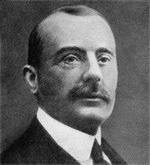 W
WThe cabinet of Alexandru Marghiloman was the government of Romania from 5 March to 23 October 1918.
 W
WDuring World War I, the Black Sea Fleet of the Romanian Navy fought against the Central Powers forces of the German Empire, the Ottoman Empire and Austria-Hungary. The Romanian warships succeeded in defending the coast of the Danube Delta, corresponding to an area around the port of Sulina, while also aiding in the Delta's defense from inland Central Powers forces.
 W
WThe 1917 Romanian Campaign consisted in three battles between late July and early September 1917, fought between Germany and Austria-Hungary on one side and Romania and Russia on the other. Romania emerged from this campaign with a slight net territorial gain and won its most important battle during the First World War.
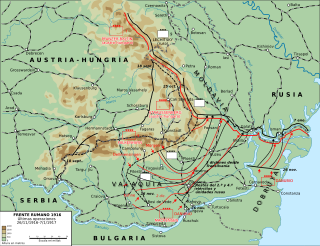 W
WThe Romanian Front was an army group level command of the Imperial Russian Army and the Romanian Army during the First World War.
 W
WThe Romanian Treasure is a collection of valuable objects and the gold reserves of the Romanian government sent to Russia for safekeeping during World War I. Only part of the objects, and none of the gold reserves have been returned as of 2020.
 W
WThe Romanian Volunteer Corps in Russia, or Volunteer Corps of Transylvanians-Bukovinians, was a military formation of World War I, created from ethnic Romanian prisoners of war held by Russia. Officially established in February 1917, it comprised abjurers of the Austro-Hungarian Army, mainly contingents from Transylvania and Bukovina. These had been obliged to fight against Romania, and, once in Russian custody, volunteered for service against the Central Powers. As campaigners for self-determination and union with Romania, they passed political resolutions which, in both tone and scope, announced those adopted on Union Day 1918.
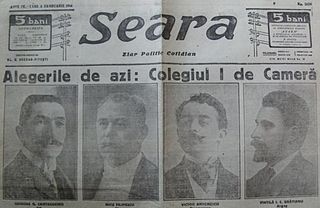 W
WSeara was a daily newspaper published in Bucharest, Romania, before and during World War I. Owned by politician Grigore Gheorghe Cantacuzino and, through most of its existence, managed by the controversial Alexandru Bogdan-Pitești, it was an unofficial and unorthodox tribune for the Conservative Party. Its involvement in politics sparked numerous scandals, the longest of which came during the neutrality period (1914–1916). Strongly anti-Slavic, Seara stood out in that context for supporting the German Empire and Central Powers, and was widely alleged of having been financed by a German propaganda machine. In 1914, it was purchased by German businessmen, but continued to register mediocre success in comparison with its pro-Entente competitors. In late 1916, after Romania decided in favor of the Entente, Seara was disestablished.